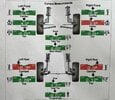Welcome to Tesla Motors Club
Discuss Tesla's Model S, Model 3, Model X, Model Y, Cybertruck, Roadster and More.
Register
Install the app
How to install the app on iOS
You can install our site as a web app on your iOS device by utilizing the Add to Home Screen feature in Safari. Please see this thread for more details on this.
Note: This feature may not be available in some browsers.
-
Want to remove ads? Register an account and login to see fewer ads, and become a Supporting Member to remove almost all ads.
You are using an out of date browser. It may not display this or other websites correctly.
You should upgrade or use an alternative browser.
You should upgrade or use an alternative browser.
Rear Camber arms option - Hardrace
- Thread starter gearchruncher
- Start date
Dannietjoh
Member
Did you install the lever arm for the sensor pointing down? As posted before:Hi All,
I've just finished installing my hardrace links at 290mm. They're the right way up (curve Down), the adjuster is outboard, I tensioned the bolts with suspension on the ground at STD height.
And the back suspension is now about 40mm lower than the front....
I drove the suspenion up and down, and all that is working but still differant by 40~mm.
Any thoughts? FYI, I don't have toolbox...
Thanks
GBYMB
Member
thanks for the reply, yep my install is the same as the pix in the posts. I ddnt touch the sensor, just unbolted from the link. bugger. I guess you meani need a toolbox calibration?.....tesla service...@GBYMB - The only thing that controls ride height is the angle of those sensors. You don't need to re-calibrate after install if it was done right. I suggest you look a bit more carefully at your install against some of the pictures in this thread,
GBYMB
Member
Yep, mines looks just like this....Did you install the lever arm for the sensor pointing down? As posted before:
GBYMB
Member
well....Tesla wont touch it...bugger.
ok, Have any of you guru's seen an adjustable version of the little plastic ball to ball rod? Which is on the adjustment sensor.
I think I've seen something somewhere..
ok, Have any of you guru's seen an adjustable version of the little plastic ball to ball rod? Which is on the adjustment sensor.
I think I've seen something somewhere..
Dannietjoh
Member
Sure, there are many topics about thatwell....Tesla wont touch it...bugger.
ok, Have any of you guru's seen an adjustable version of the little plastic ball to ball rod? Which is on the adjustment sensor.
I think I've seen something somewhere..
Model S Lowering Links-Worth it?
Hi, I'm new to the forum. Has anybody with the factory adjustable suspension tried lowering links? Looks like an inexpensive way to lower the car by an inch or so without going through major steps. I saw this guy post this.
GBYMB
Member
I agree, I've fixed the camber problem, now I just want standard height to work. I can set the suspension to high... the back is now standard height and the front is high...tesla wont touch it, and I cant get a subscription to Toolbox, in Oz.Sure, there are many topics about that
But you should not need it..
Model S Lowering Links-Worth it?
Hi, I'm new to the forum. Has anybody with the factory adjustable suspension tried lowering links? Looks like an inexpensive way to lower the car by an inch or so without going through major steps. I saw this guy post this.teslamotorsclub.com
Now , I'm looking at fooling the sensor, I'm a bit frustated.
Dannietjoh
Member
That is really not normal and should not be needed. Lowering links are just that, they allow you to lower your car but can’t make it higher. Lowering is achieved by making the link longer, normally there is no way to make them shorter. Sometimes it’s possible to lower, but just a tiny bit, older n2itive could and some of the lesser quality ones can be shortened.
GBYMB
Member
That's exactly what I'm aiming at. The ball linkages are similar to the ones in Hydraulic actuator links. I'm planning to make my own to add about 30mm to the rear, when in standard height.That is really not normal and should not be needed. Lowering links are just that, they allow you to lower your car but can’t make it higher. Lowering is achieved by making the link longer, normally there is no way to make them shorter. Sometimes it’s possible to lower, but just a tiny bit, older n2itive could and some of the lesser quality ones can be shortened.
I found this on a Lowering linkage listing "Rule of thumb, a 5mm longer length for the front represent a 1” drop on the chassis on the front wheels. For the rear, a 5mm shorter link represents a 1” drop on the rear chassis on the rear wheels."
I'm going to make a 7mm longer link....maybe it'll raise the rear by ~30mm, after I repower the car... I hope.
GBYMB
Member
Well... I decided to check out the link I was going to manufacture........

I apologise for wasting everybodys time by insisting that all was as it should be.
I was in too much of a hurry.
The car must have been soooo confused.
For those who cant see it, the actuator arm of the sensor should be pointing down, not up like mine.
I reset the link, took the car for a drive to get out of jack mode, pumped the suspension to high and back a few times and its all good.
Again, Thanks all for saying over and over 'this really isn't normal'.
I apologise for wasting everybodys time by insisting that all was as it should be.
I was in too much of a hurry.
The car must have been soooo confused.
For those who cant see it, the actuator arm of the sensor should be pointing down, not up like mine.
I reset the link, took the car for a drive to get out of jack mode, pumped the suspension to high and back a few times and its all good.
Again, Thanks all for saying over and over 'this really isn't normal'.
zoomer0056
Active Member
All is well that ends well!Well... I decided to check out the link I was going to manufacture........
View attachment 872822
I apologise for wasting everybodys time by insisting that all was as it should be.
I was in too much of a hurry.
The car must have been soooo confused.
For those who cant see it, the actuator arm of the sensor should be pointing down, not up like mine.
I reset the link, took the car for a drive to get out of jack mode, pumped the suspension to high and back a few times and its all good.
Again, Thanks all for saying over and over 'this really isn't normal'.
I reset the link, took the car for a drive to get out of jack mode, pumped the suspension to high and back a few times and its all good.
Again, Thanks all for saying over and over 'this really isn't normal'.
Glad to hear that...between you and the other guy who had said he had to drill new holes (then realized he was talking about the front...) you guys are scaring me!
Anyone in the US need a set of Camber Arms??? If so, go here.
Thank you for sharing this, it seems like something that could fly under the radar pretty easily if we're trying to get them installed too quickly.Well... I decided to check out the link I was going to manufacture........
View attachment 872822
I apologise for wasting everybodys time by insisting that all was as it should be.
I was in too much of a hurry.
The car must have been soooo confused.
For those who cant see it, the actuator arm of the sensor should be pointing down, not up like mine.
I reset the link, took the car for a drive to get out of jack mode, pumped the suspension to high and back a few times and its all good.
Again, Thanks all for saying over and over 'this really isn't normal'.
GBYMB
Member
FYI, I just had the rear alignment looked at.
The Hardrace lop links were adjusted to 290mm which put the wheel camber close to 0,0mm.
The toe , however, is at 6mm toe in. The cams are max'd out. I'll be buying some adjustable toe links today.
The Hardrace lop links were adjusted to 290mm which put the wheel camber close to 0,0mm.
The toe , however, is at 6mm toe in. The cams are max'd out. I'll be buying some adjustable toe links today.
Most people don't try to run zero camber.he Hardrace lop links were adjusted to 290mm which put the wheel camber close to 0,0mm.
The toe , however, is at 6mm toe in. The cams are max'd out. I'll be buying some adjustable toe links today.
If you run around 0.5 degrees, you can usually get away with the stock toe adjustment system.
I started this thread and all my experience is based on an X install.Does anyone know how this would impact the model X given they are the same adjustment arms? Would love to hear from someone with experience on an X. Yes I realize this is the S subsection
Aggmeister2010
Active Member
Most people don't try to run zero camber.
If you run around 0.5 degrees, you can usually get away with the stock toe adjustment system.
Agreed, it's quite rare to run "true zero" on all settings. And doing so will make the car wiggle around quite a bit more....as in, you'll require a lot of micro-corrections. And when you corner fast, you won't feel as stable....because the car uses negative camber to push the full contact surface into a corner.
I run -1.2 degrees of camber front and rear, with a bit of toe out in the front and a bit of toe in in the rear. Keeps it running straight, and still handles well.
Agreed, it's quite rare to run "true zero" on all settings. And doing so will make the car wiggle around quite a bit more....as in, you'll require a lot of micro-corrections. And when you corner fast, you won't feel as stable....because the car uses negative camber to push the full contact surface into a corner.
You are conflating toe and camber, and over-estimating what camber feels like. These are not the reasons to not run zero camber.
It's kind of funny that you are worried about a car needing micro-corrections when this is exactly what front toe out causes. If you want heavier, more stable steering, you want toe in on both axles.
Similar threads
- Replies
- 3
- Views
- 800
- Replies
- 71
- Views
- 9K
- Replies
- 4
- Views
- 4K
- Replies
- 27
- Views
- 5K



